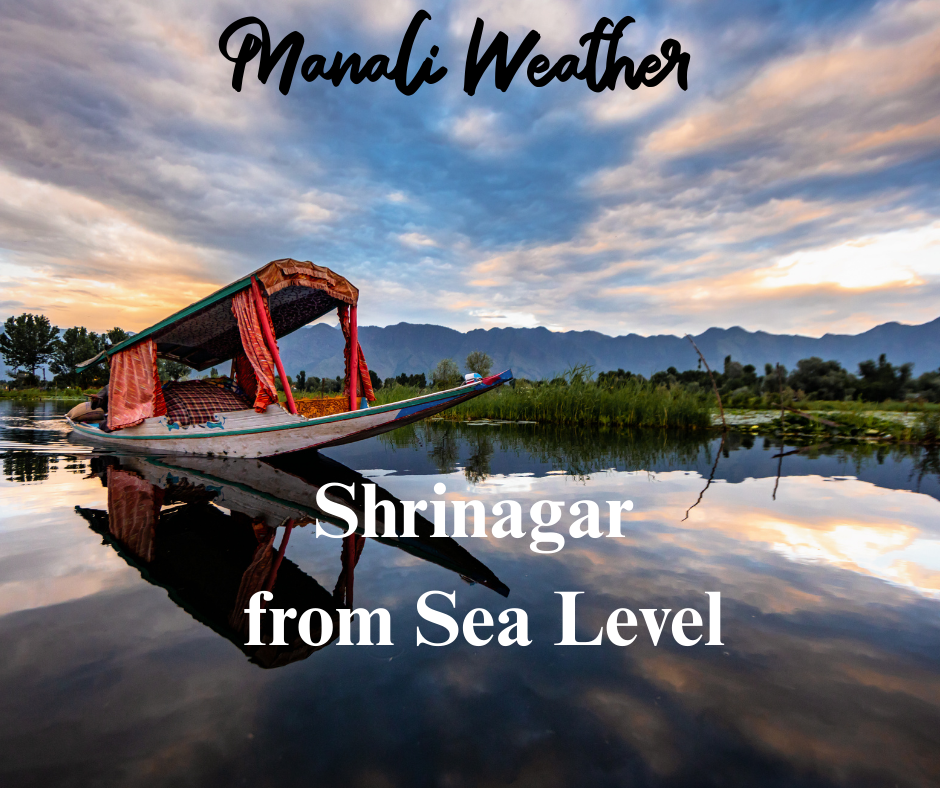Srinagar Height from Sea Level

Srinagar Height from Sea Level & Unique Valley Climate
A complete guide to Srinagar elevation, its altitude-driven climate and what Srinagar above sea level means for travellers and residents.

At a glance — how high is Srinagar?
The city of Srinagar sits in the heart of the Kashmir Valley at roughly 1,585–1,600 metres (about 5,200–5,250 feet) above sea level. This elevation places Srinagar well above plains cities and inside a broad intermontane valley, which directly influences its climate, agriculture, and tourism patterns. :contentReference[oaicite:0]{index=0}
Quick altitude facts (table)
| Place / Metric | Approx. Elevation | Notes |
|---|---|---|
| Srinagar (city center) | ≈ 1,585–1,600 m (≈ 5,200 ft) | Commonly referenced town-level elevation. :contentReference[oaicite:1]{index=1} |
| Dal Lake (surface) | ≈ 1,583 m (≈ 5,194 ft) | The lake sits within Srinagar’s basin and reflects valley elevation. :contentReference[oaicite:2]{index=2} |
| Kashmir Valley (average) | ≈ 1,850 m (≈ 6,070 ft) | Valley average — surrounding ridges and local highs vary. :contentReference[oaicite:3]{index=3} |
Why elevation shapes Srinagar’s climate
Being over 1.5 km above sea level means cooler average temperatures than the plains, a stronger diurnal range (warm days, cool nights), and seasonal contrasts that are pronounced — warm, pleasant summers and crisp to cold winters with snow in colder years. The valley location also channels winds and traps moisture, producing localized weather patterns not seen at the same latitude on flat plains. :contentReference[oaicite:4]{index=4}
Season-by-season (what visitors experience)
- Spring (Mar–May): Blooming chinar and apple orchards; mild days and cool nights — a photographer’s favourite.
- Summer (Jun–Aug): Pleasant and temperate compared with the plains; monsoon brings periodic rain and lush greenery.
- Autumn (Sep–Nov): Clear skies, crisp air and colourful foliage — excellent visibility across the valley.
- Winter (Dec–Feb): Cold nights; frost and occasional snow — higher surrounding peaks retain snow longer.
How altitude affects tourism & activities
Srinagar’s altitude and valley geography make it a versatile destination: houseboat stays and shikara rides on Dal Lake, walks through Mughal gardens, treks to nearby high viewpoints, and access to winter-snow experiences in upper reaches. The elevation also moderates summer heat, which is why many travellers choose Srinagar as a summer retreat. :contentReference[oaicite:5]{index=5}
Altitude & comfort — practical tips
- Dress in layers — daytime sun and cool evenings are typical at 1,500–1,600 m.
- Carry sun protection — UV intensity increases with altitude.
- Hydrate and rest after long travel; while Srinagar altitude rarely causes serious altitude effects, stair-climbs and hikes may feel more strenuous.
- Check local weather before planning high-altitude day trips (nearby passes and hikes can be much colder and snowier).
Srinagar vs Sea-level city — quick comparison
| Aspect | Srinagar (~1,585 m) | Typical Sea-level City |
|---|---|---|
| Summer comfort | Cooler, pleasant | Hot, often humid |
| Winter | Cold; snow possible in surrounding higher spots | Mild to cool; snow rare |
| Air quality & visibility | Generally cleaner mountain air; dramatic vistas | Urban haze common; horizons shorter |
Places where elevation is obvious (local highlights)
- Dal Lake: The lake lies within Srinagar’s basin and provides water-based tourism at valley elevation. :contentReference[oaicite:6]{index=6}
- Shankaracharya Hill & Hari Parbat: Lookouts offering panoramic views down to the city and lake.
- Gulmarg / Pahalgam nearby: Higher-altitude nearby resorts and winter-sports hubs accessible from Srinagar.
FAQs — quick answers
Q: What is Srinagar’s height from sea level?
A: Srinagar is approximately 1,585–1,600 metres (≈5,200 ft) above sea level. :contentReference[oaicite:7]{index=7}
Q: Does Srinagar get snow?
A: Winters can bring frost and snow in and around the valley, with higher surrounding areas seeing more regular snowfall. :contentReference[oaicite:8]{index=8}
Q: Is altitude a health concern?
A: At Srinagar’s elevation most people have no serious issues; mild breathlessness on climbs is common. Hydrate, rest, and layer clothing.
Conclusion — Srinagar Height from Sea Level
The Srinagar elevation around 1,585–1,600 m gives the city its cooler summers, valley microclimate, fertile orchards, and spectacular water–mountain scenery. Whether you come for houseboats on Dal Lake, spring blossoms, or winter views of snowy peaks, the city’s altitude is central to its charm and a key factor for any travel plan.





